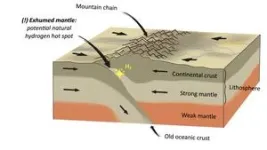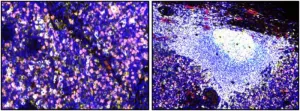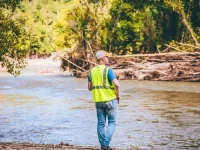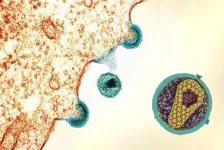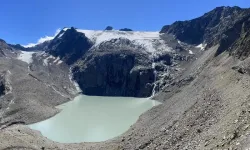(Press-News.org) The successful development of sustainable georesources for the energy transition is a key challenge for humankind in the 21st century. Hydrogen gas (H2) has great potential to replace current fossil fuels while simultaneously eliminating the associated emission of CO2 and other pollutants. However, a major obstacle is that H2 must be produced first. Current synthetic hydrogen production is at best based on renewable energies but it can also be polluting if fossil energy is used.
The solution may be found in nature, since various geological processes can generate hydrogen. Yet, until now it has remained unclear where we should be looking for potentially large-scale natural H2 accumulations.
A team of researchers led by Dr Frank Zwaan, a scientist in the Geodynamic Modelling section at GFZ Helmholtz Centre for Geosciences, present an answer to this question: using plate tectonic modelling, they found that mountain ranges in which originally deep mantle rocks are found near the surface represent potential natural hydrogen hotspots. Such mountain ranges may not only be ideal geological environments for large-scale natural H2 generation, but also for forming large-scale H2 accumulations that can be drilled for H2 production. The results of this research have now been published in the journal Science Advances. Also part of the team are Prof. Sascha Brune and Dr Anne Glerum of GFZ’s Geodynamic Modelling section. The other team members are based at Tufts University (Dr Dylan Vasey) and New Mexico Tech (Dr John Naliboff) in the USA, as well as at the University of Strasbourg (Prof. Gianreto Manatschal) and Lavoisier H2 Geoconsult (Dr Eric. C. Gaucher) in France.
Natural H2 potential in tectonic environments
Natural hydrogen can be generated in several ways, for instance by bacterial transformation of organic material or splitting of water molecules driven by decay of radioactive elements in the Earth’s continental crust. As a result, the occurrence of natural H2 is reported in many places worldwide. The general viability of natural hydrogen as an energy source has already been proven in Mali, where limited volumes of H2 originating from iron-rich sedimentary layers are produced through boreholes in the subsurface.
However, the most promising mechanism for large-scale natural hydrogen generation is a geological process in which mantle rocks react with water. The minerals in the mantle rocks change their composition and form new minerals of the so-called serpentine group, as well as H2 gas. This process is called serpentinization. Mantle rocks are normally situated at great depth, below the Earth’s crust. In order for these rocks to come in contact with water and serpentinize, they must be tectonically exhumed, i.e. being brought near the Earth’s surface. There are two main plate tectonic environments in which mantle rocks are exhumed and serpentinized over the course of millions of years: (1) ocean basins that open as continents break apart during rifting, allowing the mantle to rise as the overlying continental crust is thinned and eventually split (for example in the Atlantic Ocean), and (2) subsequent basin closure and mountain building as continents move back together and collide, allowing mantle rocks to be pushed up towards the surface (for example in the Pyrenees and Alps).
Numerical modelling helps constraining regions with natural H2 resources
A thorough understanding of how such tectonic environments evolve is key to properly assess their natural hydrogen potential. Using a state-of-the-art numerical plate tectonic modelling approach, calibrated with data from natural examples, the GFZ-led research team simulated the full plate tectonic evolution from initial rifting to continental break-up, followed by basin closure and mountain building. In these simulations, the researchers were able to determine for the first time where, when, and how much mantle rocks are exhumed in mountains, and when these rocks may be in contact with water at favorable temperatures, to allow for efficient serpentinization and natural hydrogen generation.
It turns out that conditions for serpentinization and thus natural H2 generation are considerably better in mountain ranges than in rift basins. Due to the comparably colder environment in mountain ranges, larger volumes of exhumed mantle rocks are found at favorable serpentinization temperatures of 200-350°C, and at the same time plenty of water circulation along large faults within the mountains can allow for their serpentinization potential to be realized. As a result, the annual hydrogen generation capacity in mountain ranges can be up to 20 times greater than in rift environments. In addition, suitable reservoir rocks (for example sandstones) required for the accumulation of economically viable natural H2 volumes are readily available in mountain ranges, but are likely absent during serpentinization and hydrogen generation in the deeper parts of rift basins.
Natural hydrogen exploration (and more) in mountain ranges
The results of this now published research provide a strong impulse to intensify the exploration for natural H2 in mountain ranges. In fact, various exploration efforts are already underway in places such as the Pyrenees, European Alps, and Balkans, where researchers have previously found indications of ongoing natural hydrogen generation.
“Crucial to the success of these efforts will be the development of novel concepts and exploration strategies. Of particular importance is how the formation of economic natural H2 accumulations is controlled by the tectonic history of a given exploration site. In particular, we will need to determine the timing of the key geological processes involved, because if H2 reservoirs are to form during mountain building, there must have been rifting, i.e. stretching, beforehand. So insights gained from plate tectonic simulations such as those performed in this study will be of great value”, says Frank Zwaan, lead author of the study.
Sascha Brune, head of the Geodynamic Modelling Section at GFZ, continues: “This new research advances our understanding of suitable environments for natural hydrogen generation. Given the economic opportunities associated with natural H2, now is the time to go further and also investigate migration pathways of hydrogen and deep, hydrogen-consuming microbial ecosystems to better understand where potential H2 reservoirs can actually form.”
Zwaan adds: “Overall, we may be at a turning point for natural H2 exploration. As such, we could be witnessing the birth of a new natural hydrogen industry.”
END
Natural hydrogen: a sustainable energy source in mountain ranges
GFZ researchers identify where to expect natural and exploitable hydrogen resources using state-of-the-art simulations of plate tectonic processes
2025-02-19
ELSE PRESS RELEASES FROM THIS DATE:
Scientists identify a new cancer immunotherapy target: Dysfunctional B cells
2025-02-19
University of Pittsburgh School of Medicine and UPMC Hillman Cancer Center scientists have discovered a novel subset of cancer-fighting immune cells that reside outside of their normal neighborhood – known as the tertiary lymphoid structure – where they become frustratingly dysfunctional when in close contact with tumors.
Described today in the journal Science Translational Medicine, the finding gives oncologists a new target for developing immunotherapies: double negative memory B cells, so-called because they are negative for two markers found on the surface of their more common brethren. They may also be a useful diagnostic ...
New Australian dinosaurs and the oldest megaraptorid fossils in the world
2025-02-19
Groundbreaking research published today in the Journal of Vertebrate Paleontology has unveiled a landmark discovery – fossils of the world’s oldest known megaraptorid and the first evidence of carcharodontosaurs in Australia. These finds rewrite the evolutionary history of theropod dinosaurs, uncovering a predator hierarchy unique to Cretaceous Australia.
The research, led by Museums Victoria Research Institute and Monash University PhD student Jake Kotevski, describes five theropod fossils discovered along Victoria’s coastline. The fossils were unearthed in the upper Strzelecki Group (Bunurong/Boonwurrung ...
EMBARGOED: Study reveals activity of navtemadlin in glioblastoma, points to possible treatment improvements
2025-02-19
Study Title: Window of opportunity trial reveals mechanisms of response and resistance to navtemadlin in patients with recurrent glioblastoma
Publication: Science Translational Medicine
Dana-Farber Cancer Institute authors: Veronica Rendo, PhD, Eudocia Q. Lee, MD, MPH, Veronica Rendo, PhD Patrick Y. Wen, MD, Keith L. Ligon, MD, PhD, Rameen Beroukhim, MD, PhD
Summary: Clinical research by Dana-Farber scientists suggests that combining a novel agent called navtemadlin with DNA-damaging chemotherapy for the treatment of glioblastoma, a form of brain cancer, could increase efficacy. Navtemadlin ...
Kimberly Stegmaier named as Pediatric Oncology Chair at Dana-Farber
2025-02-19
Boston - Kimberly Stegmaier, MD, was named Chair of Pediatric Oncology at Dana-Farber Cancer Institute and Associate Chief of the Division of Hematology/Oncology at Boston Children’s Hospital, in an announcement made today. Her appointment is effective April 1, 2025.
Stegmaier, a Dana-Farber, Boston Children’s Hospital, and Harvard Medical School faculty member since 2002, Stegmaier is currently Vice Chair for Pediatric Oncology Research at Dana-Farber, Co-Director of the Pediatric Hematologic Malignancy Program at Dana-Farber and Boston Children’s Hospital, Co-Leader for the Dana-Farber/Harvard Cancer Center Leukemia Program, and a Professor ...
Human Immunome Project and Michelson Medical Research Foundation award $150,000 grants to three early-career scientists researching immunology and vaccines
2025-02-19
NEW YORK – The Human Immunome Project (HIP) and Michelson Medical Research Foundation (MMRF) have awarded Dr. Omar Abudayyeh (Brigham and Women’s Hospital; Harvard Medical School), Dr. Caleb Lareau (Memorial Sloan Kettering Cancer Center), and Dr. Yuzhong Liu (Scripps Research) the 2024 Michelson Prizes: Next Generation Grants.
The $150,000 research grants are awarded annually to support early-career scientists advancing human immunology, vaccine discovery, and immunotherapy research for major global diseases.
“Investing in bold, early-career scientists fuels the high-risk, high-reward ideas ...
Devastating storms define Appalachia’s 2024 climate
2025-02-19
After a year of weather extremes that brought everything from deadly floods to bitter cold, experts at East Tennessee State University have released a detailed analysis of the region’s 2024 weather patterns.
Their findings highlight both record-breaking temperatures and catastrophic storms – underscoring the growing need for preparedness as communities face unpredictable conditions.
The report, published by Tennessee’s Climate Office housed at ETSU, details how Southern Appalachia endured scorching heat and devastating floods, including the tragic September storm linked to ...
CRISPR manipulates plants’ flower powers
2025-02-19
Humans have appreciated the beauty of flowers for centuries. Yet, flowers aren’t just aesthetically pleasing. They also play a crucial role in plant reproduction. In all plants, a well-studied gene with a curious name, Unusual Floral Organs (UFO), orchestrates the flowering process. UFO expression hinges on another complex process called cis-regulation. And this one has remained a “black box” of plant biology research for years.
Now, using CRISPR gene editing, Cold ...
Text message tool addresses “time toxicity” for cancer patients
2025-02-19
PHILADELPHIA – Cancer patients spend a lot of time on their care. Meeting with doctors and other members of their health care team, getting labs and other tests, picking up prescriptions, and undergoing treatment all takes time. So does getting to and from each appointment, sitting in the waiting room between each appointment, and so on.
In recent years, cancer researchers have worked to quantify the level of “time toxicity” or time spent commuting to, waiting for, and receiving cancer treatment. Now, for the first time, a pilot study has shown it’s possible to use digital technology to safely ...
New therapy may effectively control HIV in Uganda
2025-02-19
A multi-national, multi-institutional study led by Weill Cornell Medicine investigators found little natural resistance to a new HIV therapy called lenacapavir in a population of patients in Uganda.
The study, published Jan. 30 in the Journal of Antimicrobial Chemotherapy, adds to growing evidence that lenacapavir may be a powerful new tool in the global anti-HIV drug arsenal. Approximately, 1.5 million people are living with HIV in Uganda.
“Our data shows that only 1.6% of the individuals studied are living with HIV ...
Global retreat of glaciers has strongly accelerated
2025-02-19
There are currently around 275,000 glaciers worldwide, in which huge quantities of fresh water are stored. But this reservoir is increasingly shrinking. Since the turn of the millennium, glaciers around the world – i.e. ice masses on land excluding the Greenland and Antarctic ice sheets – have lost around 273 billion tonnes of ice per year. This corresponds to about five and a half times the volume of Lake Constance. Overall, the world’s glaciers have lost around five per cent of their total volume since the year 2000. This is the conclusion reached by an international research team of which Tobias Bolch from the Institute of Geodesy ...
LAST 30 PRESS RELEASES:
University of Oklahoma researcher awarded funding to pursue AI-powered material design
Exploring how the visual system recovers following injury
Support for parents with infants at pediatric check-ups leads to better reading and math skills in elementary school
Kids’ behavioral health is a growing share of family health costs
Day & night: Cancer disrupts the brain’s natural rhythm
COVID-19 vaccination significantly reduces risk to pregnant women and baby
The role of vaccination in maternal and perinatal outcomes associated with COVID-19 in pregnancy
Mayo Clinic smartwatch system helps parents shorten and defuse children's severe tantrums early
Behavioral health spending spikes to 40% of all children’s health expenditures, nearly doubling in a decade
Digital cognitive behavioral treatment for generalized anxiety disorder
Expenditures for pediatric behavioral health care over time and estimated family financial burden
Air conditioning in nursing homes and mortality during extreme heat
The Alps to lose a record number of glaciers in the next decade
What makes a good proton conductor?
New science reporting guide published for journalists in Bulgaria
New international study reveals major survival gaps among children with cancer
New science reporting guide published for journalists in Turkey
Scientists develop a smarter mRNA therapy that knows which cells to target
Neuroanatomy-informed brain–machine hybrid intelligence for robust acoustic target detection
Eight SwRI hydrogen projects funded by ENERGYWERX
The Lundquist Institute and its start-up company Vitalex Biosciences Announces Strategic Advancement of Second-Generation fungal Vaccine VXV-01 through Phase 1 Trials under $40 Million Competitive Con
Fine particles in pollution are associated with early signs of autoimmune disease
Review article | Towards a Global Ground-Based Earth Observatory (GGBEO): Leveraging existing systems and networks
Penn and UMich create world’s smallest programmable, autonomous robots
Cleveland researchers launch first major study to address ‘hidden performance killer’ in athletes
To connect across politics, try saying what you oppose
Modulating key interaction prevents virus from entering cells
Project explores barriers to NHS career progression facing international medical graduates
Jeonbuk National University researchers explore the impact of different seasonings on the flavor perception of Doenjang soup
Two Keck Medicine of USC Hospitals named Leapfrog Top Teaching Hospitals
[Press-News.org] Natural hydrogen: a sustainable energy source in mountain rangesGFZ researchers identify where to expect natural and exploitable hydrogen resources using state-of-the-art simulations of plate tectonic processes

